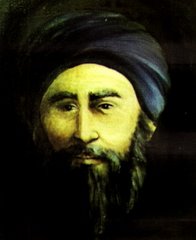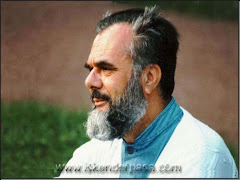The following article was published in the Dominion Post in Wellington New Zealand on Tuesday 24 July 2007, a few days after the storming of the Lal Masjid (Red Mosque) by Pakistani security forces in Islamabad, Pakistan's capital ...
For the past month until early last week, over 1,000 theology students and their
instructors turned a mosque and adjoining religious colleges into a heavily
armed fortress. They kidnapped foreign nationals and enforced their own
vigilante brand of sharia law. They smuggled heavy weapons and took over
adjoining state-owned buildings, including a library. Burqa-clad female students
pledged martyrdom before international media
And all this in the
centre of Islamabad, within minutes of the National Assembly and within a block
of the headquarters of the powerful Inter-Services Intelligence (ISI).
When Muslim militants can show such utter disregard to the rule of law,
something must surely be rotten in the state of Pakistan.
The
leaders of the rebellion, Maulana’s Abdul Aziz and Abdul Rashid Ghazi (‘Maulana’
is an honorific title commonly given to religious scholars in the Indian
subcontinent), openly called for the introduction of hudood (capital punishment
for select crimes). Whilst holding mock crimina trials for rape cases, they
also defiled their mosque with threats of suicide bombing attacks. They sought
to inject their demented version of “Islamic” back into the Islamic Republic of
Pakistan, the country’s official title.
The siege ended when
Pakistani troops stormed the complex at 4:30am on Tuesday 10 July 2007 in what
was labelled Operation Sunrise. Reports vary on the number of persons killed.
The government puts the figure at less than 150, while the opposition religious
Jamaat-i-Islami party puts the figure in the thousands. Already nationwide
protests are being led by religious and other opposition
parties.
That a mosque could be turned into a fortress of lawless
militancy raises issues going to the heart of Pakistan ’s identity crisis. Just
how Islamic is Pakistan meant to be? Or rather, why kind of Islam do Pakistanis
want to see in their homeland? The Lal Masjid (literally ‘Red Mosque’) rebellion
and its bloody end reflect the deep ideological divide that has plagued the
country since independence.
Pakistan is a nation founded on the
basis of ethno-religious identity, on a presumption that Indian Muslims were
somehow a separate nation from the rest of India. Yet in his speech to Pakistan’s first parliament on 11 August 1947, Pakistan ’s founder Mohammad Ali Jinnah
declared:
“You are free … to go to your temples, you are free to
go to your mosques or to any other place or worship in this State of Pakistan.
You may belong to any religion or caste or creed that has nothing to do with the
business of the State … [I]n course of time Hindus would cease to be Hindus and
Muslims would cease to be Muslims, not in the religious sense, because that is
the personal faith of each individual, but in the political sense as citizens of
the State.”
Yet in the years leading upto Partition, the Pakistan
cause had little support from Muslim religious figures. The Indian Muslim League
was led by the very secular elitist Jinnah, a Bombay barrister who spent much of
his working life practising law in English courts. Although involved in Indian
secular politics since 1913, it was only in 1940 that Jinnah publicly announced
his support for a separate Muslim state.
Indian Muslim historian
Asghar Ali Engineer sums up Jinnah’s vision of Pakistan : “Thus politics, not
religion was responsible for partition … It is true that Mr Jinnah spearheaded
the movement and he articulated the aspirations of the Muslim elite, especially
of the Muslim minority areas”.
Jinnah’s secular modernist
vision of Pakistan very much resembled that of Mustafa Kemal Ataturk, founder of
modern Turkey . However, Ataturk was able to successfully control religious
orders and mosques due to Ottoman Turkey’s historic tradition of ensuring
religious bodies remained subservient to the state.
Unlike Turkey ,
South Asian Muslim religious institutions and figures have always fiercely
guarded their independence from any governmental authority. Prominent religious
leaders with close links to the impoverished Muslim masses opposed the Creation
of Pakistan. These included a prominent Indian religious scholar Syed Hussein
Ahmed Madani, known among Indian Muslims by the title of “Sheik al-Hind” or
spiritual elder of India .
Madni and his colleagues in the
Deobandi sect regarded Muslim separatism as forbidden in Islam. Another
prominent Islamic scholar, Maulana Abul Kalam Azad, was close to Gandhi and
became India ’s first education minister. The founder of Pakistan ’s largest
religious party, Abul Ala Maududi, was himself opposed to Partition at first.
Indeed, only one major Deobandi scholar was known to have supported the creation
of Pakistan. It’s little wonder that more Muslims remained in India than move
to the new Muslim state.
Despite the elitism of the secular vision
for Pakistan, secular politics has done surprisingly well. Pakistan ’s
religious parties have, until recently, performed poorly at the polls. Secular
politics has thrived for a variety of reasons. Firstly, Pakistan’s Muslim
identity couldn’t overcome pre-existing tribal, linguistic and other
non-religious identities.
Secondly, Pakistan is still an
overwhelmingly rural society. The main secular parties are dominated by powerful
rural (almost feudal) landed families such as the Bhutto and Zardari clans.
Soviet intervention in Afghanistan helped undermine secular
parties. Pakistan was a key ally of the United States, and was at the forefront
of supporting militant Afghan rebel groups. Pakistan also played host to Arab
mujahideen leaders supported by the United States, including a prominent member
of the Saudi bin-Ladin family.
For decades, the most radical
religious groups and parties have had the support of the army, ISI and state and
provincial governments. This cosy relationship worked well when supporting
religious radicals suited Pakistan ’s foreign policy objectives in Afghanistan
and Kashmir. However, supporting radicalism abroad eventually had adverse
consequences back home.
The Lal Masjid is not the first mosque to
be sympathetic to more radical versions of religion. So why did the army wait so
long before acting against the militants? And why were preliminary steps (such
as cutting off water and electricity to the mosque) not tried before the attack
and its consequential loss of life? Some Pakistani observers believe President
Musharraf acted deliberately so as to convince the West that he is the only
person able to stop Pakistan descending into a full-blown
theocracy.
Opposition figure and former Pakistan cricket captain
Imran Khan wrote in the Canberra Times on 13 July that Musharraf should keep in
mind “Indira Gandhi’s order for troops to attack the [Sikh] Golden Temple ”. Yet
the Red Mosque hardly plays an equivalent role to the holiest shrine of Sikhism.
Still, even those opposed to the theocratic politics of militant religious
parties will be upset by the desecration of a mosque.
The real test
for Musharraf and for Pakistan will be seen in the coming months. Pakistan’s
former Chief Justice, sacked by Musharraf, has become a key symbol for more
secular-minded forces in the opposition. Should they join forces with the
better-resourced and organised theocratic parties, Musharraf’s stated plans of
ridding Pakistan of Muslim extremism may come to naught. Ironically, this may
strengthen Musharraf’s support in the West. Yet again, a Muslim dictator might
just survive with Western backing. In the long run, such a development will only
strengthen the appeal of theocratic trends in Pakistan.
© Irfan Yusuf 2007










